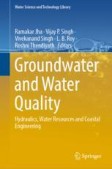Search
Search Results
-
Groundwater arsenic removal using raw and modified Nagarparkar Pakistani Kaolin
Raw and modified Nagarparkar Pakistani Kaolin (NPK) was used to remove arsenic from groundwater by adsorption technique. Both the NPK samples were...

-
Functionalized graphitic carbon nitride as adsorbent for the removal of arsenic and lead from groundwater
Water pollution caused by highly toxic arsenic (As) and lead (Pb) poses a serious threat to water quality. Hence, the development of materials for...

-
Arsenic Removal from Groundwater Using Iron Pyrite: Influence Factors and Removal Mechanism
Iron pyrite has been reported as a kind of potential material for arsenic (As) removal from the groundwater because it exhibits a strong attraction...
-
Simultaneous removal of fluoride and arsenic from drinking groundwater using limestones from Bajío Guanajuatense, Mexico
Numerous groundwater wells in Mexico exceed the maximum allowable fluoride (F − ) and arsenic (As) drinking water concentration requirements, posing an...

-
A review on arsenic removal from wastewater using carbon nanotube and graphene-based nanomaterials as adsorbents
Arsenic being the twentieth most abundant metalloid in the earth’s crust is one of the most hazardous elements both for humans and animals. Arsenic...

-
Removal of Arsenic from Chlamys farreri with Different Methods
Arsenic is commonly found in seafood, and the toxicity of different speciation varies widely. Therefore, there is an urgent need to reduce the...
-
Assessing the impact of seasonal groundwater variability on the performance of arsenic removal by iron amended ceramic filter
Iron (Fe) amended ceramic filters (CFs) have been proven to be the sustainable, low-cost method for arsenic (As) removal from groundwater. The impact...

-
Arsenic removal using calcium hydroxyapatite synthesized from paper mill sludge
Calcium hydroxyapatite (Ca-HAp) was synthesized from calcium carbonate (CaCO 3 ) extracted from a paper mill sludge. The extraction of CaCO 3 was...

-
Arsenic Control for Hazard Risk Reduction
Arsenic (As) is natural element, which can spread in the environment to a great extent due to human activities. Exposure to As in drinking water and...
-
Novel iron-based nanocomposites for arsenic removal in groundwater: insights from their synthesis to implementation for real groundwater remediation
The presence of arsenic in water samples of different nature represents a serious problem with severe consequences all around the world, but mainly...

-
Nanotechnology for Water Treatment: Is It the Best Solution Now?
In conclusion, the role of nanotechnology in water treatment is overestimated; while advantages are not more than theoretical assumptions, while the...
-
Quality assessment of drinking water of Multan city, Pakistan in context with Arsenic and Fluoride and use of Iron nanoparticle doped kitchen waste charcoal as a potential adsorbent for their combined removal
In majority cities of Pakistan, ground water is the main source of drinking water supply in the taps. Studies from different areas of Pakistan...

-
Advancements in utilizing almond-shell-based materials for the adsorptive removal of hazardous pollutants from water: a 10-year review
The widespread contamination of water sources by hazardous pollutants poses a significant environmental and health challenge. This comprehensive...

-
The effect of electrocoagulation (EC) on total arsenic, arsenite (As3+) and arsenate (As5+) species removal from model groundwater investigating toxicity and sludge characteristic
This study showed that the model groundwater containing As 3+ and As 5+ species was successfully treated with electrocoagulation (EC) first time in the...

-
Active Treatment Methods for Mine Water
Twelve active mine water treatment methods form the core of this chapter. They do not follow any particular order, except that at the start the most...
-
Removal process of cadmium from unsafe water by slow sand filtration: study of water feed flow rate effect
In regions facing water scarcity, the reuse of wastewater in agriculture introduces unique challenges, particularly the need to mitigate metallic...

-
Nanofiltration membranes types and application in water treatment: a review
Global water shortages force the world to explore every possible way to reduce water consumption and reduction of exploitation of freshwater...

-
Management of Arsenic Sludge Using Solidification
In this paper, the management of arsenic sludge residue, which was produced during the treatment of arsenic contaminated water by the coagulation...
-
Application of Synthetic Iron Oxyhydroxide with Influencing Factors for Removal of As(V) and As(III) from Groundwater
Synthesized iron oxyhydroxide was applied for the adsorptive removal of As(V) and As(III) from the aquas media. Additionally, this investigation...
-
Advances in graphene-based materials for the treatment of water
Water treatment and recycling are the most important issues in the present scenario due to the paucity of safe water supply. Therefore, many methods...

